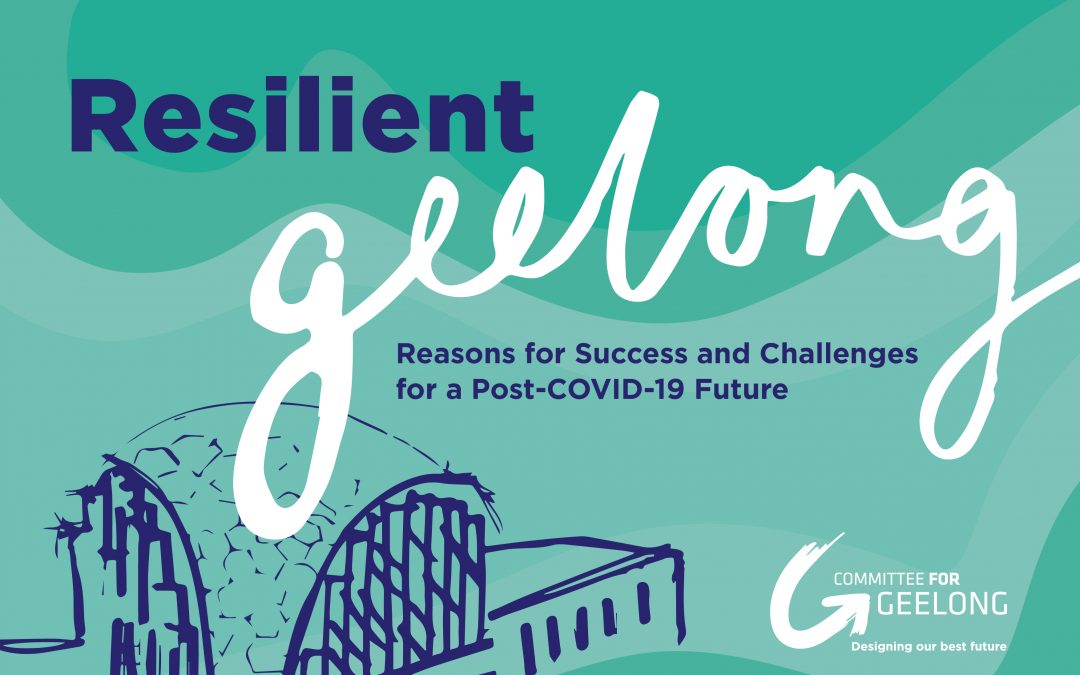Committee for Geelong launches Resilient Geelong – Reasons for Success and Challenges for a Post-COVID-19 Future research paper today
The Committee for Geelong has launched the Resilient Geelong research paper today which includes a range of recommendations focusing on employment and work, urban design and social inclusion initiatives for the Geelong region in a post-COVID world.
Tracking Geelong’s economic and social resilience over three decades, the 116-page research paper details Geelong’s journey of employment, population growth and key economic sectoral change with the aim of provoking and providing guidance for innovative ideas and collaboration for a socially and economically inclusive and prosperous Geelong.
According to the Committee for Geelong’s CEO Jennifer Cromarty, Resilient Geelong is just the start of a conversation with the community to build on Geelong’s historic resilience and plan for both ongoing risks and future economic shocks.
“The COVID-19 pandemic is a global health crisis with significant social and economic consequences. The impact has forced government, private and public organisations, communities, families and individuals to act swiftly and adapt to a new economic and social reality. As a community, we now need to focus on how Geelong will accelerate the recovery,” Ms Cromarty said.
Authored by Honorary Professor Dr Louise Johnson, Dr Meg Mundell and Rebecca Bartel from Deakin University, Resilient Geelong is designed to contribute to the public discussion of regional resilience, how and why Geelong has bounced back from major economic disruptions in the past, and how these lessons might apply to a post-COVID-19 future.
“Geelong has survived and ultimately thrived despite textile and clothing manufacturing decline, the collapse of the Pyramid Building Society, the Global Financial Crisis, closures of manufacturing plants at Ford and Alcoa, and natural disasters such as the Millennium drought.
“Resilient Geelong covers the journey of employment, the diversification of the economy and the development of strategic sectoral specialisations. This, along with population growth, has acted as an economic shock absorber and helped to withstand setbacks and significant community loss. It also reviews how coordinated government policy and community leadership have also been pivotal for Geelong to absorb, adapt and transform, as well as mitigate some of the negative effects of economic disruptions. When the community works together, we all benefit,” said Ms Cromarty.
Resilient Geelong also makes 15 recommendations, which aims to inform the local organisations, community and government as they plan for our recovery from the impacts of COVID-19.
“Several recommendations are already being progressed via strategic initiatives with the Committee for Geelong, which will form part of our focus for the next 12 months:
- Future of Work – development of a local action plan with a focus on skills development, youth employment and pathways to work and the impact of digital on flexible work.
- Brand Geelong project via the City of Greater Geelong’s Vision Partners Forum to inform a creative campaign positioning Geelong as a great place to live, work, study & invest.
- Creative Industries sector strategic planning for the region in partnership with G21 Geelong Region Alliance and local cultural and creative organisations.
- Gateway Cities Alliance study into Supply Chain & Logistics with the City of Greater Geelong, City of Newcastle and Wollongong City Council.
- Gateway Cities Alliance partnership with Deakin University, University of Newcastle and University of Wollongong working with regional health agencies regarding opportunities in medical research.
- An evidenced-based retail and commercial strategy for Geelong.
- Ongoing collaboration with other local advocacy organisations that formed the Geelong COVID Collective during 2020 which builds on the ‘one voice’ for Geelong concept.
“Other recommendations are being addressed through recent announcements from the Victorian and Federal Government including funding and initiatives in social housing, investment in local manufacturing and infrastructure for the Great Ocean Road and Geelong rail, incentives for research & development, support for tourism campaigns and Skilling the Bay, increased capacity of broadband infrastructure to Geelong via NBN, and a range of projects to support renewable energy and the circular economy.
“There are also recommendations, which focus on the urban design of Geelong and its sustainability and liveability which we believe needs to be addressed in partnership with local, state and federal government planning and investment. Some of these recommendations may be realised through the City Deal, the drafting of the Central Geelong Framework Plan and Revitalising Central Geelong initiatives. However, the Committee for Geelong will continue to advocate for long-term strategic planning for Geelong through ‘Plan Geelong’ as a significant opportunity to deliver on the work of Vision 2 of which the Green Spine project is just one element, and support the community’s 30 year Clever and Creative vision,” Ms Cromarty said.
The Committee for Geelong was founded in 2001 and works with members and stakeholders with the purpose of designing Geelong’s best future.
To read the Resilient Geelong research paper in full please click here.
Media contact: Jennifer Cromarty, CEO, Committee for Geelong M: 0413241033; jennifer.cromarty@committeeforgeelong.com.au
